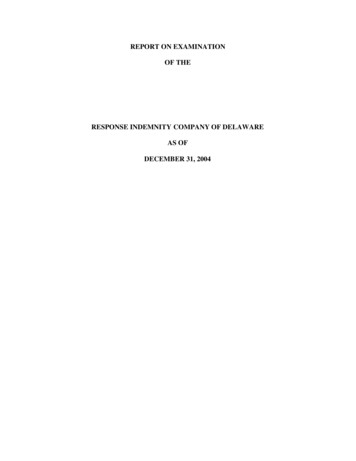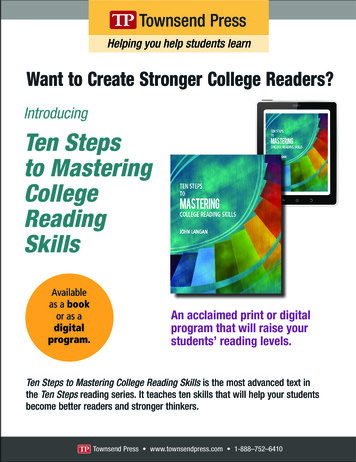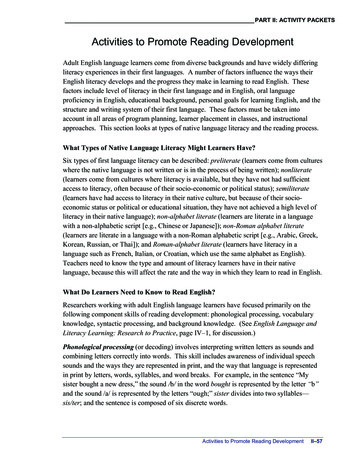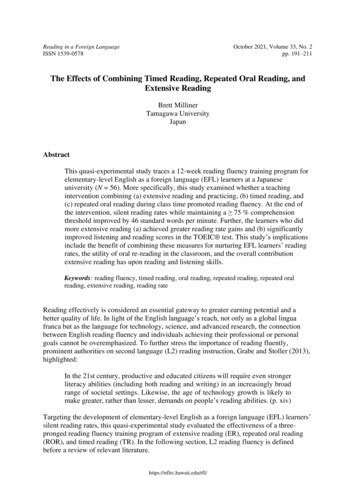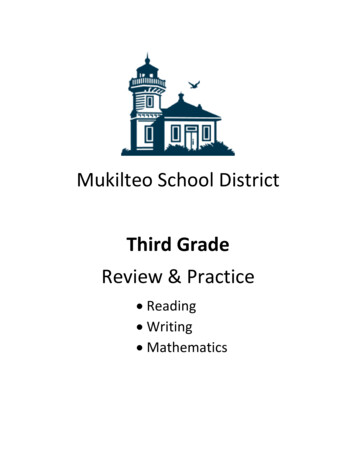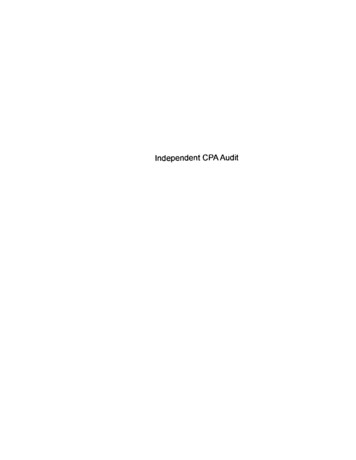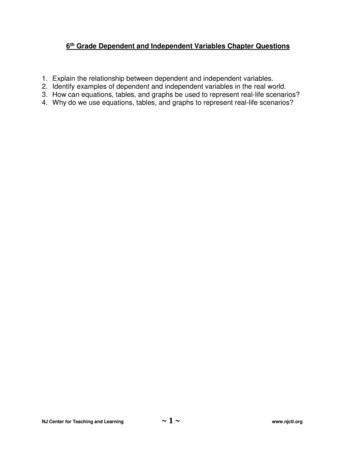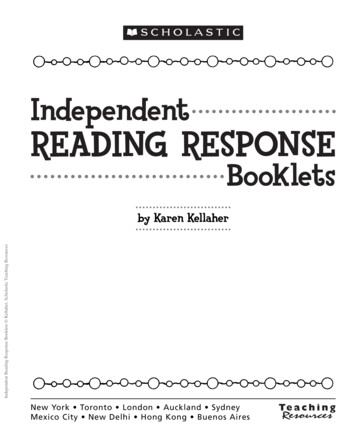
Transcription
IndependentREADING RESPONSEBookletsIndependent Reading Response Booklets Kellaher, Scholastic Teaching Resourcesby Karen KellaherNew York Toronto London Auckland SydneyMexico City New Delhi Hong Kong Buenos Aires
DedicationScholastic Inc. grants teachers permission to photocopy the reproduciblepages from this book for classroom use. No other part of this publicationmay be reproduced in whole or in part, or stored in a retrieval system, ortransmitted in any form or by any means, electronic, mechanical, photocopying, recording, or otherwise, without written permission of the publisher. For information regarding permission, write to Scholastic Inc.,557 Broadway, New York, NY 10012.Cover design by Josué CastillejaInterior design by Ellen Matlach for Boultinghouse & Boultinghouse, Inc.Cover and interior illustrations by Teresa AnderkoISBN: 0-439-39513-5Copyright 2004 by Karen KellaherPublished by Scholastic Inc.All rights reserved.Printed in the U.S.A.1 2 3 4 5 6 7 8 9 104011 10 09 08 07 06 05 04Independent Reading Response Booklets Kellaher, Scholastic Teaching ResourcesTo Mo Bearwith love.
ContentsIntroduction . . . . . . . . . . . . . . . . . . . . . . . . . . . . . . 4How to Use This Book . . . . . . . . . . . . . . . . . . . . . . 5Making and Using the Booklets . . . . . . . . . . . . . . 6Booklets for FictionIndependent Reading Response Booklets Kellaher, Scholastic Teaching ResourcesImagine That . . . . . . . . . .A Writing “Ad”venture . . . .My Advice Column . . . . . . . .Character Scrapbook . . . . . .How I See It . . . . . . . . . . . . .My Book of Lists for Fiction .Reporter’s Notebook . . . . . .The Envelope, Please . . . .1115171923273033My Book of Lists for Nonfiction. . . .Reader’s Report Card . . . . . . . . . . . .Up, Up, and Away With Nonfiction!Read to Learn! . . . . . . . . . . . . . . . . .Postcards From . . . . . . . . .Nonfiction Newspaper . . . . . . . . . . .Ask the Expert . . . . . . . . . . . . . . . . . . . . . . 38. . . . . . 41. . . . . . 45. . . . . . 49. . . . . . 53. . . . . . 57. . . . . . 61Booklets for Nonfiction
IntroductionWelcome to Independent Reading ResponseBooklets—an instant and engaging way forstudents to respond to any fiction ornonfiction book! Each of the 15 reproduciblebooklets is full of creative writing promptsthat guide students to reflect on what they’veread. Students will enjoy the variety ofbooklets, each with its own fun and uniqueapproach, such as an advice column, areporter’s notebook, a character scrapbook,and a newspaper. In the process, they’llexplore character, setting, conflict andresolution, point of view, main idea anddetails, visual aids, and more. These bookletshelp students accomplish the following:Connections to theLanguage Arts StandardsRespond to both fiction and nonfiction.Uses reading skills and strategies to understand and interpret a variety of literary texts Uses reading skills and strategies to understand a varietyof literary passages and texts (e.g., fairy tales, folktales,fiction, nonfiction, myths, poems, fables, fantasies,historical fiction, biographies, autobiographies, chapterbooks) Understands the basic concept of plot (e.g., mainproblem, conflict, resolution, cause and effect) Understands elements of character development inliterary works (e.g., the importance of a character’sactions, motives, and appearance to plot and theme)Boost reading comprehension.The writing prompts encourage students torespond thoughtfully to the text and provideexamples to support their ideas.Engage in meaningful writing.Students write about important andinteresting aspects of the books they’ve readto create their own personalized booklets.Uses the general skills and strategies of thewriting process Writes in response to literature (e.g., summarizes mainideas and significant details; relates own ideas tosupporting details; advances judgments; supportsjudgments with references to the text)Uses reading skills and strategies tounderstand and interpret a variety ofinformational texts Understands the main idea and supporting details ofsimple expository information Summarizes information found in texts (e.g., retells inown words) Summarizes and paraphrases information in texts (e.g.,includes the main idea and significant supporting detailsof a reading selection) Uses prior knowledge and experience to understand andrespond to new informationSource: Content Knowledge: A Compendium of Standards andBenchmarks for K–12 Education, 4th edition (Mid-continentResearch for Education and Learning)4Independent Reading Response Booklets Kellaher, Scholastic Teaching ResourcesYou’ll find eight booklets for fiction thatfocus on literary elements and seven bookletsthat highlight the elements of nonfiction.These booklets help students meet thefollowing language arts standards outlined byMid-continent Research for Education andLearning (McREL), a nationally recognizednonprofit organization that collects andsynthesizes national and state K–12 standards.
How to Use This BookYou can incorporate these booklets into anyindependent reading program and use themin a number of ways. The following aresuggested guidelines.MyAdviceColumnDraw your picture in thebox.My Name:Book Title:Author:is an album forscrapbook? A scrapbookclippings,Have you ever made apictures, letters, newspapercollecting all kinds of things:of a book!can fit between the pagesand anything else thatabout the characterswill collect informationIn this scrapbook, youin the book,If you can’t find the informationin your fictional book.the character.what you know aboutmake a guess based onNonfiction books can helpyou learnabout a topic that interestsyou. Afterreading a nonfiction book,record theinformation you learnedin this booklet.Book Title:a day with a characterWhat if you could spendOr write a sequel to it?from your fictional book?questions.to answer these and otherUse your imaginationCharacter 1:My Name:Character 2:Character 3:Book Title:Independent Reading ResponseResourcesBooklets Scholastic TeachingAuthor:Getting StartedIndependent Reading Response Booklets Kellaher, Scholastic Teaching ResourcesThese booklets were designed for independent use. Based on students’ needs, you mightassign parts of a booklet rather than all of it,or you might have them complete a fewpages at a time. For an additional challenge,use one or more of the prompts as the basisfor a longer writing assignment.My Name:Author:characters. Start by writingChoose three importantin the boxes below. Thenthe characters’ namespage for each character.complete one scrapbookMeeting Students’ NeedsThe first eight booklets were designed forresponding to fictional books and theremaining seven for nonfiction books. Theywork for a variety of text levels, from picturebooks to chapter books. Students can usethese booklets to respond to independentreading or to a book you’ve read togetheras a class.In advance, review the teaching notes foreach booklet on pages 6–10. Before studentsbegin working on a booklet, review thedirections on each page with them. Ifstudents need additional guidance, completea booklet together based on a book you’veread as a class. You might have students workon the same booklet or different booklets.You can also assign the same booklet fordifferent books throughout the year. Oncestudents are familiar with the booklets, youmight have them choose which booklet theywould like to complete. To guide students’selections, store the booklets in folderslabeled “fiction” or “nonfiction” along withthe names of the booklets.Assessing Students’ WorkThe prompts in these booklets move beyondfactual questions so that students truly reflecton what they’ve read. They encouragestudents to develop their own ideas aboutthe material and to support their ideas withevidence from the text. In addition, thecreative nature of the booklets motivateschildren to personalize their work with theirown creative flair.Reading-response booklets provide awindow into what students are learning,thinking, feeling, and wondering about theirindependent reading. The completed bookletscan be used for assessment of both readingcomprehension and writing skills. Collect thebooklets and provide constructive feedbackon the thoroughness and thoughtfulness ofstudents’ responses. If students are completing one section at a time, you might respondto each section as they complete it, or youmight respond to the whole booklet oncethey have finished. The booklets also providea helpful starting place for book conferenceswith students. If time allows, invite studentsto share favorite sections of their bookletswith small groups or the whole class (remindthem not to give away the endings of theirbooks). Completed booklets also make a niceaddition to students’ writing portfolios.5
Making and Using the BookletsImagine That pages 11–14 FictionPoint out that thebooklet is shaped like athought balloon toemphasize that studentsshould use their imagination to answer thequestions. Explain that students should useinformation from their books to answer thebooklet questions creatively. Remind studentsthat many of the questions ask them toexplain their answers.a day with a characterWhat if you could spendOr write a sequel to it?from your fictional book?questions.to answer these and otherUse your imaginationMy Name:Book Title:Author:6Assembly: Make double-sided copies of thebooklet pages. Fold each page in half alongthe dotted line and nest the pages innumerical order. Cut out the shape and staplealong the top edge.What if you couldspend a daywith a charactefrom your fictionalrbook? Or writeUse your imaginaa sequel to it?tion to answerthese and otherquestions.My Name:Book Title:Imagina new e that theauthorAuthor:endendaskedthe sto ing for thisyoury?book.How to writewouldyourcharactewith a.el to it?d a daya sequr questionsd spenyou coul book? Or writethese and otheWhat iffictionalanswerfrom your imagination toUse youre:My Nam:Book TitleAuthor:2A Writing “Ad”venturepages 15–16 FictionIn this booklet, students willA Writing “Ad”venturecreate small ads that looklike those in the yellowpages. They will chooseproducts or services thatcould help a particularcharacter solve a problem.Read aloud the text on thecover and ask students toname a few kinds of products and services.Then show them advertisements from theyellow pages, as well as from newspapers ormagazines. Ask students to describe thefeatures of an ad (such as persuasive text andillustrations or photos). Review the directionstogether and brainstorm examples ofproducts that could help well-knowncharacters. For example, Cinderella could usea reliable wristwatch to help her return fromthe ball on time. Encourage students to referto the sample advertisements for inspirationas they are writing.tries toAn advertisement, or ad,ing. An adconvince you to buy somethsomeone cancookie) or a service thatkitchen sink).perform (like fixing yourers in yourThink about the charactfictional book.What products orservices mighthelp them solvetheir problems?My Name:Book Title:Author:Assembly: Make double-sided copies of thebooklet pages. Fold the page in half alongthe dotted line.Independent Reading Response Booklets Kellaher, Scholastic Teaching ResourcesFollow the instructions for photocopying eachbooklet. Then demonstrate the assemblydirections for students so they can puttogether their own booklets. Most of thebooklets are designed for double-sidedcopying. If your copier has a double-sidedfunction, carefully remove the perforatedbooklet pages and make double-sided copies.If your copier does not have a doublesided function, make single-sided copies ofthe first page. Place these copies in the papertray and make copies of the second page sothat it appears on the back of the first page.Check to be sure that the pages are copyingexactly as they appear in the book (forexample, with booklet page 1 appearingdirectly behind the cover). You may need toexperiment with the placement of pages inthe paper tray and the direction of pages tobe copied. Follow the same steps with anyremaining pages, again checking that pagesare copying as they appear in the book.When folding the pages, fold carefullyalong the dotted lines. Fold the first page sothat the cover appears on the outside. Foldthe second page so that booklet page 2appears on the outside.
My Advice Columnpages 17–18 FictionIn this booklet, studentsMywill write short letters fromAdviceColumncharacters describing aproblem they are having.Then they’ll respond as anadvice columnist with some helpful words ofwisdom. Share an age-appropriate advicecolumn with children. (If you can’t find one,write a short, imaginary letter and response.)Explain that people sometimes use pen nameswhen signing off because they don’t want toreveal their identities. Review the directionswith students and provide some examples ofproblems and solutions. You might assign thisbooklet while students are still reading thebook, so they won’t know how the characters’problems are solved. If students havecompleted the book, ask them to think ofalternate solutions to the problems. Invitestudents to make up fun pen names for theircharacters to use in signing off (for example,“Nervous in Nevada”).box.Draw your picture in theMy Name:Book Title:Independent Reading Response Booklets Kellaher, Scholastic Teaching ResourcesAuthor:Assembly: Make double-sided copies of thebooklet pages. Cut the page in half along thesolid line. Place the pages in numerical orderand fold along the dotted line. Staple alongthe left edge.Character Scrapbookpages 19–22 FictionDescribe the purpose ofa scrapbook and, ifpossible, bring in asample to show students.Tell students that theywill be creating scrapbook pages for threecharacters in their book.If they would like toinclude additional characters, provide extraA scrapbook is an album forHave you ever made a scrapbook?letters, newspaper clippings,collecting all kinds of things: pictures,the pages of a book!and anything else that can fit betweeninformation about the charactersIn this scrapbook, you will collectthe information in the book,findin your fictional book. If you can’tknow about the character.make a guess based on what youStart by writingChoose three important characters.below. Thenthe characters’ names in the boxeseach character.complete one scrapbook page forCharacter 1:Character 2:Character 3:Independent Reading Response BookletsScholastic Teaching Resourcescopies of booklet pages 1–3. Review thewriting and drawing prompts on each page.Explain that for favorite quotation, studentsshould choose something that the charactersaid that they enjoyed or thought wasimportant. If students need additionalguidance, make an overhead transparency ofone of the scrapbook pages. Then fill it intogether with information about a characterfrom a book you’ve read as a class.Assembly: Make single-sided copies of thebooklet pages. Have students complete thepages before stapling them together alongthe left side.How I See Itpages 23–26 FictionMy Name:aWhen you are readingbook, do you ever wonderhow someone else mighttell the same story? Howifwould your book change?it had a different narratoraThis booklet gives youchance to find out!This booklet illustratesthe concept of point ofview and guides studentsto imagine how theirbook would change if there were a differentnarrator. This assignment works especiallywell with stories that have a central conflictor disagreement because it’s interesting toimagine how each character would tell thetale from his or her perspective.Before beginning, discuss the factors thatcontribute to point of view (past experiences,character traits and opinions, and so on).Then talk about the two kinds of narratorsdescribed on booklet page 1. If possible, showan example of a book with each kind ofnarrator. If point of view is a new concept forstudents, choose a book that you’ve read as aclass or read aloud a picture book to students.Work together to choose an event andsummarize it from the perspectives ofdifferent characters. Then fill in the booklettogether. If students need extra support, havethem tell you the event and characters thatthey chose before they begin writing. Or havestudents choose only one new narrator.Book Title:Author:7
Assembly: Make double-sided copies of thebooklet pages. Fold each page in half alongthe dotted line and nest the pages innumerical order. Cut out the shape and staplealong the top edge.My Book of Listsfor Fictionpages 27–29 FictionWhen? How? and Why? Tell students thatthey will answer one of these questions oneach page of their notebooks. Once studentshave completed their booklets, you mighthave them write a full news story based onone important event in their book.Assembly: Make single-sided copies of theMy Book ofLists for Fictionitems that relateIn this booklet, you’ll make lists ofinterestingto your fictional book: new words,more.characters, important places, andIn this booklet, students willmake lists of items that relateFive Wordsto their book—five newFour CharactersThree Partswords, four interestingTwo Placescharacters, three favoriteOne Reviewparts, two important places,and one book review. Invite students to usethe blank reverse sides of the booklet pagesto add illustrations.My Name:booklet pages. Have students cut along thesolid lines to create six elongated bookletpages. Arrange the pages in numerical orderand staple along the top edge.Book Title:Author:booklet pages. Cut along the solid lines tocreate six booklet pages of different heights.Stack the pages on top of each other in orderby size, as shown. Place the longest page onthe bottom and the shortest page (the cover)on top. Align the pages along the top edgeand staple them together.pages 30–32 Fiction8This booklet gives The Envelope, Pleasestudents the chanceto nominate certainaspects of theirbooks for an award,name a winner, and explain their selection.Point out that this booklet is based on anawards ceremony, such as those shown ontelevision for actors. Describe the proceedingsof an awards ceremony. You might assignstudents all of the awards or select a few. Thelast award template is blank so that studentsmay create their own award category.d byThese awards are presente.(your name)Book Title:Author:1AAssembly: For each booklet, you will needReporter’s NotebookAsk students what they think areporter would use anotebook for. What might thereporter record in it? Explainthat students will have achance to pretend they arereporting on the book they’vejust read. They’ll even get anotebook to record theirobservations. Review thequestions answered in a newsarticle: Who? What? Where?pages 33–37 FictionreportersWhen writing a news story,s:answer six big questionWho? What? Where?Why?When? How? anda reporter!Now it’s your turn to beyour fictionalDig up some details fromthebook. Use them to answer’s notebook.questions in your reporterfive plain business-size envelopes. Place eachenvelope with the flap facingyou, open the flap, andcut off the right cornerof the flap, as shown.This will make the flapseasier to open once thebooklet is assembled.Stack the envelopeswith the flaps facingdown and staple alongthe left side.Make single-sided copies of the bookletpages and cut out all the boxes. Some boxeswill be glued onto the envelopes and othersIndependent Reading Response Booklets Kellaher, Scholastic Teaching ResourcesAssembly: Make single-sided copies of theThe Envelope, Please
will be folded and inserted into theenvelopes, as follows:Reader’s Report Cardpages 41–44 NonfictionEnvelope 1: Glue page 1A ontothe front of theenvelope. Close the flap andglue page 1B ontothe back.The Envelope, Please These awards are presented by(your name).Book Title:Author:Open the envelope and read the directions inside.1Abe the teacher and gradeHere’s your chance tothis booklet, you will giveyour nonfiction book. Ination, visual aids,your book grades for organiz why you gave eachExplainwriting style, and more.from the book.grade, using examplesCongratulations!You have been selected as an official judge of theBest in Reading Awards. For each category, you willchoose three nominees (or possible winners) fromyour book. Then think carefully about which onedeserves to win the award and why.1BIndependent Reading Response Booklets Kellaher, Scholastic Teaching ResourcesMy Book of Listsfor Nonfictionpages 38–40 NonfictionA Knocked my socks off!B Good work!C Got the job done.D Needs improvement.F Missed the target.My Name:Envelope 2: Glue page 2A onto thefront of the envelope. Fold page 2B and placeinside. Glue a box with the text“And the award goesto ” onto the back.(Follow the same steps forenvelopes 3–5.)In this booklet, studentsgrade their nonfictionReader’sbooks on interest level,Report Cardorganization, visual aids,writing style, and information. Instruct students toprovide explanations foreach grade they assign andinclude specific examplesfrom the text. If studentshave read the same book, have them work insmall groups to compare their evaluations.Book Title:Author:Here are the nominees for best character:(Draw a picture of each character. Write their names on the lines.)2AAssembly: Make double-sided copies of theAnd theawardgoes to My Book of Listsfor Nonfictionlists of items that relateIn this booklet, you’ll makeyou read: new words,to your nonfiction bookmore.ns about the topic, andinteresting facts, questioIn this booklet, students willmake lists of items thatFive Wordsrelate to their book—fiveFour Factsnew words, four interestingThree Visual AidsTwo Questionsfacts, three helpful visualOne Reviewaids, two questions about thetopic, and one book review.Invite students to use the blank reverse sidesof the booklet pages to add illustrations.My Name:Book Title:Author:Assembly: Make single-sided copies of thebooklet pages. Cut along the solid lines tocreate six booklet pages of different heights.Stack the pages on top of each other in orderby size, as shown. Place the longest page onthe bottom and the shortest page (the cover)on top. Align the pages along the top edgeand staple them together.booklet pages. Fold each page in half alongthe dotted line and nest the pages innumerical order. Staple along the left edge.Up, Up, and AwayWith Nonfiction!pages 45–48 NonfictionIn this booklet, studentsUp, Up,answer a variety of questionsand AwayWith Nonfiction!about their books—fromrecalling their favorite part tobrainstorming a new title andcover. To introduce thebooklet, discuss the idea thatreading a nonfiction book islike taking a trip: you seenew sights, meet new people, and learn lotsof interesting things. Encourage students tothink about all the things they learned intheir book.Nonfiction books can take you to all kindsof places! Where did your book take you?In this booklet, you will write about what yousaw in your book and what you learned.My Name:Book Title:Author:Assembly: Make double-sided copies of thebooklet pages. Fold each page in half alongthe dotted line and nest the pages innumerical order. Cut out the shape and staplealong the left edge.9
Read to Learn!pages 49–52 Nonfictionofbeen hired as the editorCongratulations! You’veeris to create a newspapa newspaper. Your jobnonfiction book.about the topics in yourstrips, this newspaperFrom news stories to comiclearnedyouoninformatiis a chance to share thefrom your book.you learnNonfiction books can helpyou. Afterabout a topic that interestsrecord thereading a nonfiction book,in this booklet.information you learnedMy Name:Book Title:Author:Book Title:Author:Assembly: Make double-sided copies of thebooklet pages. Fold each page in half alongthe dotted line and nest the pages innumerical order. Cut out the shape and staplealong the left side.Postcards FromAssembly: Make double-sided copies of thepages 53–56 NonfictionThis booklet is a collectionof three postcards thatstudents write andillustrate about threeimportant things in theirbook—a person (or animal), a place, and anobject. Encourage students to describe eachand explain its importance in the book. Showstudents several postcards for inspiration.main setting of bookEveryone loves to get a postcard!In this booklet,you’ll write three postcards aboutdifferent thingsyou learned about in your nonfictionbook.Assembly: Make double-sided copies of thebooklet pages. Cut along the solid lines,arrange in numerical order, and staple alongthe left side.Nonfiction Newspaperpages 57–60 NonfictionIntroduce and assign one section of thisbooklet at a time. Show students thedifferent sections of a real newspaper forinspiration. Then provide examples of howthey might create each section, based on a10My Name:booklet pages. Have students fold along thedotted lines and nest the pages in numericalorder. Staple along the left edge.Ask the Expertpages 61–64 NonfictionIn this lift-theAsk theExpertflap booklet,students imaginethey are expertson their booksand answer a series of questions. The lastquestion is left blank for students to fill inand answer. Direct students to fold open theflaps and write their responses on the lines.My Name:an expert onYou’ve been selected asjust finished. Book Title:the nonfiction book youthen writeRead the questions andAuthor:flaps.the answers beneath theQuestion:What is themost importantthing you learnedabout the topic?Question:Question:What are threeinteresting factsothers might notknow aboutthe topic?Question:What is one of themost importantplaces in the book?What is the mostinterestingillustration, chart,or other visual aidin the book? Why?Assembly: Make double-sided copies of thebooklet pages. Fold each page in half alongthe dotted line. Cut along the solid lines tocreate flaps. Place the pages back to backwith the flaps facing out,as shown, and stapleAsk theExpertalong the top edge.You’ve been selected asan expert on My Name:the nonfiction book youjust finished.Read the questions andBook Title:then writethe answers beneath theflaps.Author:Question:What is themost importantthing youlearnedabout thetopic?Question:What are threeinteresting factsothers might notknow aboutthe topic?Question:Question:What is one of themost importantplaces in the book?What is the mostinterestingillustration, chart,or other visual aidin the book? Why?Independent Reading Response Booklets Kellaher, Scholastic Teaching ResourcesIn this booklet, students exploreseveral elements of nonfiction.Read the directions on eachpage together and provideexamples of responses. Youmight have students work on thisbooklet while they are readingtheir books so they can be on thelookout for examples to include.nonfiction book you’ve readNONFICTIONtogether. For example, aNEWSPAPERnewspaper on a book aboutthe Wright brothers mightinclude: a top story about theirfirst flight a help wanted ad for a jobat a bike shop a real estate ad for oceanfront property inKitty Hawk, North Carolina a letter to the editor explaining theimportance of the Wright brothers’accomplishment a cartoon showing surprised birds watchingthe first human flight an ad for the trade fair in St. Louis, wherethe first successful pilot was rewarded
Imagine that it is your job to write a sequel tothis book. A sequel is a book that takes placeafter the first book and tells what happens next.What would happen in your book?Independent Reading Response Booklets Kellaher, Scholastic Teaching Resources711 What if you could spend a day with a characterfrom your fictional book? Or write a sequel to it?Use your imagination to answer these and other questions.My Name:Book Title:Author:
12Independent Reading Response Booklets Kellaher, Scholastic Teaching ResourcesImagine that you could visit the setting of thebook for a day. (Remember that setting is timeand place.) How would you spend the day?1Imagine that you were asked to write a newtitle for the book. What title would you chooseand why?6
Imagine that you could ask the author aquestion about the book. What would you ask?How do you think the author would respond?Question:Answer:Independent Reading Response Booklets Kellaher, Scholastic Teaching Resources513 Imagine that the author asked you to writea new ending for this book. How would youend the story?2
14Independent Reading Response Booklets Kellaher, Scholastic Teaching ResourcesImagine that you could give a gift to the maincharacter in the story. What would you giveand why?3Imagine that you could ask a character in thebook a question. What would you ask and why?How do you think the character would respond?Question:Answer:4
15Independent Reading Response Booklets Kellaher, Scholastic Teaching ResourcesIn the box, draw an ad for the product or service.How?What product or service might help this character?What is this character’s problem?Name:Character 3 Author:Book Title:My Name:An advertisement, or ad, tries toconvince you to buy something. An adcan tell about a product (like a toy orcookie) or a service that someone canperform (like fixing your kitchen sink).Think about the characters in yourfictional book.What productsor services mighthelp them solvetheir problems?A Writing “Ad”venture
How?What product or service might help this character?What is this character’s problem?Name:Character 1In the box, draw an ad for the product or service.How?What product or service might help this character?What is this character’s problem?Name:Character 2Independent Reading Response Booklets Kellaher, Scholastic Teaching ResourcesIn the box, draw an ad for the product or service.16
(your name)(character’s name),,75Independent Reading Response Booklets Kellaher, Scholastic Teaching ResourcesSigned,You shouldDear(your name)ADVICE FOR PROBLEM 3Signed,(character’s name)ADVICE FOR PROBLEM 2You shouldDear17Author:Book Title:My Name:MyAdviceColumnSigned,W
responding to fictional books and the remaining seven for nonfiction books. They work for a variety of text levels, from picture books to chapter books. Students can use these booklets to respond to independent reading or to a book you’ve read together as a class. In advance, review the


